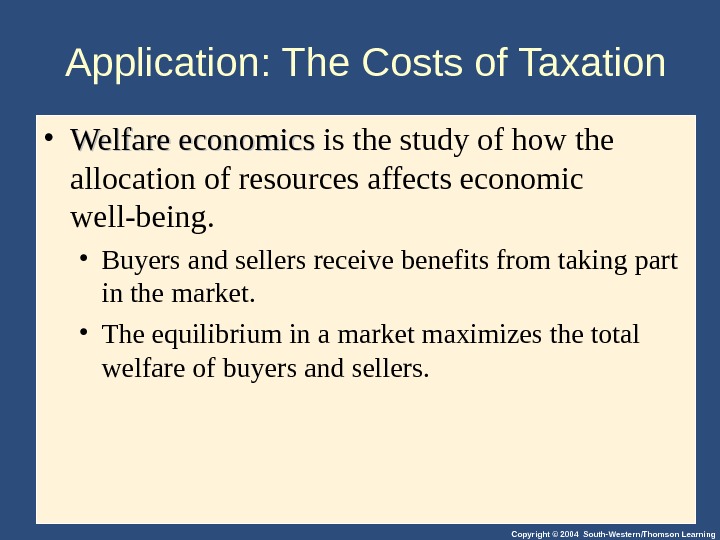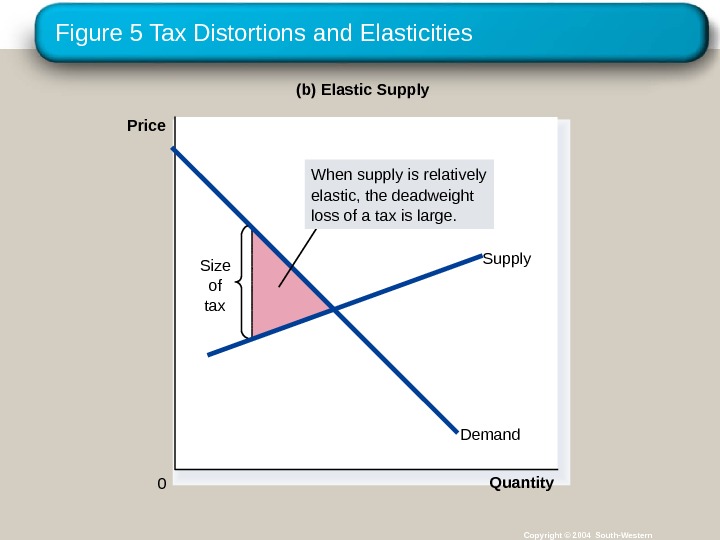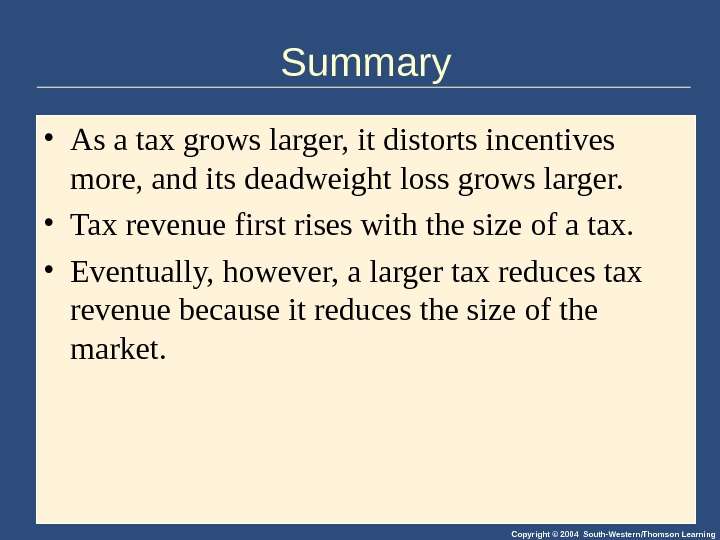Copyright© 2004 South-Western 88 Application: The Costs of


































session3_appliction_of_taxation.ppt
- Размер: 797.5 Кб
- Количество слайдов: 33
Описание презентации Copyright© 2004 South-Western 88 Application: The Costs of по слайдам
 Copyright© 2004 South-Western 88 Application: The Costs of Taxation
Copyright© 2004 South-Western 88 Application: The Costs of Taxation
 Copyright © 2004 South-Western/Thomson Learning. Application: The Costs of Taxation • Welfare economics is the study of how the allocation of resources affects economic well-being. • Buyers and sellers receive benefits from taking part in the market. • The equilibrium in a market maximizes the total welfare of buyers and sellers.
Copyright © 2004 South-Western/Thomson Learning. Application: The Costs of Taxation • Welfare economics is the study of how the allocation of resources affects economic well-being. • Buyers and sellers receive benefits from taking part in the market. • The equilibrium in a market maximizes the total welfare of buyers and sellers.
 Copyright © 2004 South-Western/Thomson Learning. THE DEADWEIGHT LOSS OF TAXATION • How do taxes affect the economic well-being of market participants?
Copyright © 2004 South-Western/Thomson Learning. THE DEADWEIGHT LOSS OF TAXATION • How do taxes affect the economic well-being of market participants?
 Copyright © 2004 South-Western/Thomson Learning. THE DEADWEIGHT LOSS OF TAXATION • It does not matter whether a tax on a good is levied on buyers or sellers of the good. . . the price paid by buyers rises, and the price received by sellers falls.
Copyright © 2004 South-Western/Thomson Learning. THE DEADWEIGHT LOSS OF TAXATION • It does not matter whether a tax on a good is levied on buyers or sellers of the good. . . the price paid by buyers rises, and the price received by sellers falls.
 Figure 1 The Effects of a Tax Copyright © 2004 South-Western. Size of tax Quantity 0 Price buyers pay Price sellers receive Demand. Supply Price without tax Quantity without tax. Quantity with tax
Figure 1 The Effects of a Tax Copyright © 2004 South-Western. Size of tax Quantity 0 Price buyers pay Price sellers receive Demand. Supply Price without tax Quantity without tax. Quantity with tax
 Copyright © 2004 South-Western/Thomson Learning. How a Tax Affects Market Participants • A tax places a wedge between the price buyers pay and the price sellers receive. • Because of this tax wedge, the quantity sold falls below the level that would be sold without a tax. • The size of the market for that good shrinks.
Copyright © 2004 South-Western/Thomson Learning. How a Tax Affects Market Participants • A tax places a wedge between the price buyers pay and the price sellers receive. • Because of this tax wedge, the quantity sold falls below the level that would be sold without a tax. • The size of the market for that good shrinks.
 Copyright © 2004 South-Western/Thomson Learning. How a Tax Affects Market Participants • Tax Revenue • T = the size of the tax • Q = the quantity of the good sold TT QQ = the government’s tax revenue
Copyright © 2004 South-Western/Thomson Learning. How a Tax Affects Market Participants • Tax Revenue • T = the size of the tax • Q = the quantity of the good sold TT QQ = the government’s tax revenue
 Figure 2 Tax Revenue Copyright © 2004 South-Western. Tax revenue ( T × Q) Size of tax ( T ) Quantity sold ( Q ) Quantity 0 Price Demand. Supply Quantity without tax. Quantity with tax. Price buyers pay Price sellers receive
Figure 2 Tax Revenue Copyright © 2004 South-Western. Tax revenue ( T × Q) Size of tax ( T ) Quantity sold ( Q ) Quantity 0 Price Demand. Supply Quantity without tax. Quantity with tax. Price buyers pay Price sellers receive
 Figure 3 How a Tax Effects Welfare Copyright © 2004 South-Western A F B D C E Quantity 0 Price Demand Supply = P B Q 2= P SPrice buyers pay Price sellers receive = P 1 Q 1 Price without tax
Figure 3 How a Tax Effects Welfare Copyright © 2004 South-Western A F B D C E Quantity 0 Price Demand Supply = P B Q 2= P SPrice buyers pay Price sellers receive = P 1 Q 1 Price without tax
 Copyright © 2004 South-Western/Thomson Learning. How a Tax Affects Market Participants • Changes in Welfare • A deadweight loss is the fall in total surplus that results from a market distortion, such as a tax.
Copyright © 2004 South-Western/Thomson Learning. How a Tax Affects Market Participants • Changes in Welfare • A deadweight loss is the fall in total surplus that results from a market distortion, such as a tax.
 Copyright © 2004 South-Western/Thomson Learning. How a Tax Affects Welfare
Copyright © 2004 South-Western/Thomson Learning. How a Tax Affects Welfare
 Copyright © 2004 South-Western/Thomson Learning. How a Tax Affects Market Participants • The change in total welfare includes: • The change in consumer surplus, • The change in producer surplus, and • The change in tax revenue. • The losses to buyers and sellers exceed the revenue raised by the government. • This fall in total surplus is called the deadweight loss.
Copyright © 2004 South-Western/Thomson Learning. How a Tax Affects Market Participants • The change in total welfare includes: • The change in consumer surplus, • The change in producer surplus, and • The change in tax revenue. • The losses to buyers and sellers exceed the revenue raised by the government. • This fall in total surplus is called the deadweight loss.
 Copyright © 2004 South-Western/Thomson Learning. Deadweight Losses and the Gains from Trade • Taxes cause deadweight losses because they prevent buyers and sellers from realizing some of the gains from trade.
Copyright © 2004 South-Western/Thomson Learning. Deadweight Losses and the Gains from Trade • Taxes cause deadweight losses because they prevent buyers and sellers from realizing some of the gains from trade.
 Figure 4 The Deadweight Loss Copyright © 2004 South-Western. Cost to sellers Value to buyers. Size of tax Quantity 0 Price Demand Supply. Lost gains from trade Reduction in quantity due to the tax. Price without tax Q 1 P B Q 2 P S
Figure 4 The Deadweight Loss Copyright © 2004 South-Western. Cost to sellers Value to buyers. Size of tax Quantity 0 Price Demand Supply. Lost gains from trade Reduction in quantity due to the tax. Price without tax Q 1 P B Q 2 P S
 Copyright © 2004 South-Western/Thomson Learning. DETERMINANTS OF THE DEADWEIGHT LOSS • What determines whether the deadweight loss from a tax is large or small? • The magnitude of the deadweight loss depends on how much the quantity supplied and quantity demanded respond to changes in the price. • That, in turn, depends on the price elasticities of supply and demand.
Copyright © 2004 South-Western/Thomson Learning. DETERMINANTS OF THE DEADWEIGHT LOSS • What determines whether the deadweight loss from a tax is large or small? • The magnitude of the deadweight loss depends on how much the quantity supplied and quantity demanded respond to changes in the price. • That, in turn, depends on the price elasticities of supply and demand.
 Figure 5 Tax Distortions and Elasticities Copyright © 2004 South-Western(a) Inelastic Supply Price 0 Quantity. Demand. Supply Size of tax When supply is relatively inelastic, the deadweight loss of a tax is small.
Figure 5 Tax Distortions and Elasticities Copyright © 2004 South-Western(a) Inelastic Supply Price 0 Quantity. Demand. Supply Size of tax When supply is relatively inelastic, the deadweight loss of a tax is small.
 Figure 5 Tax Distortions and Elasticities Copyright © 2004 South-Western(b) Elastic Supply Price 0 Quantity. Demand Supply Size of tax When supply is relatively elastic, the deadweight loss of a tax is large.
Figure 5 Tax Distortions and Elasticities Copyright © 2004 South-Western(b) Elastic Supply Price 0 Quantity. Demand Supply Size of tax When supply is relatively elastic, the deadweight loss of a tax is large.
 Figure 5 Tax Distortions and Elasticities Copyright © 2004 South-Western. Demand Supply(c) Inelastic Demand Price 0 Quantity. Size of tax When demand is relatively inelastic, the deadweight loss of a tax is small.
Figure 5 Tax Distortions and Elasticities Copyright © 2004 South-Western. Demand Supply(c) Inelastic Demand Price 0 Quantity. Size of tax When demand is relatively inelastic, the deadweight loss of a tax is small.
 Figure 5 Tax Distortions and Elasticities Copyright © 2004 South-Western(d) Elastic Demand Price 0 Quantity. Size of tax Demand. Supply When demand is relatively elastic, the deadweight loss of a tax is large.
Figure 5 Tax Distortions and Elasticities Copyright © 2004 South-Western(d) Elastic Demand Price 0 Quantity. Size of tax Demand. Supply When demand is relatively elastic, the deadweight loss of a tax is large.
 Copyright © 2004 South-Western/Thomson Learning. DETERMINANTS OF THE DEADWEIGHT LOSS • The greater the elasticities of demand supply: • the larger will be the decline in equilibrium quantity and, • the greater the deadweight loss of a tax.
Copyright © 2004 South-Western/Thomson Learning. DETERMINANTS OF THE DEADWEIGHT LOSS • The greater the elasticities of demand supply: • the larger will be the decline in equilibrium quantity and, • the greater the deadweight loss of a tax.
 Copyright © 2004 South-Western/Thomson Learning. DEADWEIGHT LOSS AND TAX REVENUE AS TAXES VARY • The Deadweight Loss Debate • Some economists argue that labor taxes are highly distorting and believe that labor supply is more elastic. • Some examples of workers who may respond more to incentives: • Workers who can adjust the number of hours they work • Families with second earners • Elderly who can choose when to retire • Workers in the underground economy (i. e. , those engaging in illegal activity)
Copyright © 2004 South-Western/Thomson Learning. DEADWEIGHT LOSS AND TAX REVENUE AS TAXES VARY • The Deadweight Loss Debate • Some economists argue that labor taxes are highly distorting and believe that labor supply is more elastic. • Some examples of workers who may respond more to incentives: • Workers who can adjust the number of hours they work • Families with second earners • Elderly who can choose when to retire • Workers in the underground economy (i. e. , those engaging in illegal activity)
 Copyright © 2004 South-Western/Thomson Learning. DEADWEIGHT LOSS AND TAX REVENUE AS TAXES VARY • With each increase in the tax rate, the deadweight loss of the tax rises even more rapidly than the size of the tax.
Copyright © 2004 South-Western/Thomson Learning. DEADWEIGHT LOSS AND TAX REVENUE AS TAXES VARY • With each increase in the tax rate, the deadweight loss of the tax rises even more rapidly than the size of the tax.
 Figure 6 Deadweight Loss and Tax Revenue from Three Taxes of Different Sizes Copyright © 2004 South-Western. Tax revenue Demand Supply Quantity 0 Price Q 1(a) Small Tax Deadweight loss P B Q 2 P S
Figure 6 Deadweight Loss and Tax Revenue from Three Taxes of Different Sizes Copyright © 2004 South-Western. Tax revenue Demand Supply Quantity 0 Price Q 1(a) Small Tax Deadweight loss P B Q 2 P S
 Figure 6 Deadweight Loss and Tax Revenue from Three Taxes of Different Sizes Copyright © 2004 South-Western. Tax revenue Quantity 0 Price (b) Medium Tax P B Q 2 P S Supply Demand Q 1 Deadweight loss
Figure 6 Deadweight Loss and Tax Revenue from Three Taxes of Different Sizes Copyright © 2004 South-Western. Tax revenue Quantity 0 Price (b) Medium Tax P B Q 2 P S Supply Demand Q 1 Deadweight loss
 Figure 6 Deadweight Loss and Tax Revenue from Three Taxes of Different Sizes Copyright © 2004 South-Western. T a x re v e n u e. Demand Supply Quantity 0 Price Q 1(c) Large Tax P B Q 2 P S Deadweight loss
Figure 6 Deadweight Loss and Tax Revenue from Three Taxes of Different Sizes Copyright © 2004 South-Western. T a x re v e n u e. Demand Supply Quantity 0 Price Q 1(c) Large Tax P B Q 2 P S Deadweight loss
 Copyright © 2004 South-Western/Thomson Learning. DEADWEIGHT LOSS AND TAX REVENUE AS TAXES VARY • For the small tax, tax revenue is small. • As the size of the tax rises, tax revenue grows. • But as the size of the tax continues to rise, tax revenue falls because the higher tax reduces the size of the market.
Copyright © 2004 South-Western/Thomson Learning. DEADWEIGHT LOSS AND TAX REVENUE AS TAXES VARY • For the small tax, tax revenue is small. • As the size of the tax rises, tax revenue grows. • But as the size of the tax continues to rise, tax revenue falls because the higher tax reduces the size of the market.
 Figure 7 How Deadweight Loss and Tax Revenue Vary with the Size of a Tax Copyright © 2004 South-Western(a) Deadweight Loss 0 Tax Size
Figure 7 How Deadweight Loss and Tax Revenue Vary with the Size of a Tax Copyright © 2004 South-Western(a) Deadweight Loss 0 Tax Size
 Figure 7 How Deadweight Loss and Tax Revenue Vary with the Size of a Tax Copyright © 2004 South-Western(b) Revenue (the Laffer curve) Tax Revenue 0 Tax Size
Figure 7 How Deadweight Loss and Tax Revenue Vary with the Size of a Tax Copyright © 2004 South-Western(b) Revenue (the Laffer curve) Tax Revenue 0 Tax Size
 Copyright © 2004 South-Western/Thomson Learning. DEADWEIGHT LOSS AND TAX REVENUE AS TAXES VARY • As the size of a tax increases, its deadweight loss quickly gets larger. • By contrast, tax revenue first rises with the size of a tax, but then, as the tax gets larger, the market shrinks so much that tax revenue starts to fall.
Copyright © 2004 South-Western/Thomson Learning. DEADWEIGHT LOSS AND TAX REVENUE AS TAXES VARY • As the size of a tax increases, its deadweight loss quickly gets larger. • By contrast, tax revenue first rises with the size of a tax, but then, as the tax gets larger, the market shrinks so much that tax revenue starts to fall.
 Copyright © 2004 South-Western/Thomson Learning. CASE STUDY: The Laffer Curve and Supply-side Economics • The Laffer curve depicts the relationship between tax rates and tax revenue. • Supply-side economics refers to the views of Reagan and Laffer who proposed that a tax cut would induce more people to work and thereby have the potential to increase tax revenues.
Copyright © 2004 South-Western/Thomson Learning. CASE STUDY: The Laffer Curve and Supply-side Economics • The Laffer curve depicts the relationship between tax rates and tax revenue. • Supply-side economics refers to the views of Reagan and Laffer who proposed that a tax cut would induce more people to work and thereby have the potential to increase tax revenues.
 Copyright © 2004 South-Western/Thomson Learning. Summary • A tax on a good reduces the welfare of buyers and sellers of the good, and the reduction in consumer and producer surplus usually exceeds the revenues raised by the government. • The fall in total surplus—the sum of consumer surplus, producer surplus, and tax revenue — is called the deadweight loss of the tax.
Copyright © 2004 South-Western/Thomson Learning. Summary • A tax on a good reduces the welfare of buyers and sellers of the good, and the reduction in consumer and producer surplus usually exceeds the revenues raised by the government. • The fall in total surplus—the sum of consumer surplus, producer surplus, and tax revenue — is called the deadweight loss of the tax.
 Copyright © 2004 South-Western/Thomson Learning. Summary • Taxes have a deadweight loss because they cause buyers to consume less and sellers to produce less. • This change in behavior shrinks the size of the market below the level that maximizes total surplus.
Copyright © 2004 South-Western/Thomson Learning. Summary • Taxes have a deadweight loss because they cause buyers to consume less and sellers to produce less. • This change in behavior shrinks the size of the market below the level that maximizes total surplus.
 Copyright © 2004 South-Western/Thomson Learning. Summary • As a tax grows larger, it distorts incentives more, and its deadweight loss grows larger. • Tax revenue first rises with the size of a tax. • Eventually, however, a larger tax reduces tax revenue because it reduces the size of the market.
Copyright © 2004 South-Western/Thomson Learning. Summary • As a tax grows larger, it distorts incentives more, and its deadweight loss grows larger. • Tax revenue first rises with the size of a tax. • Eventually, however, a larger tax reduces tax revenue because it reduces the size of the market.

